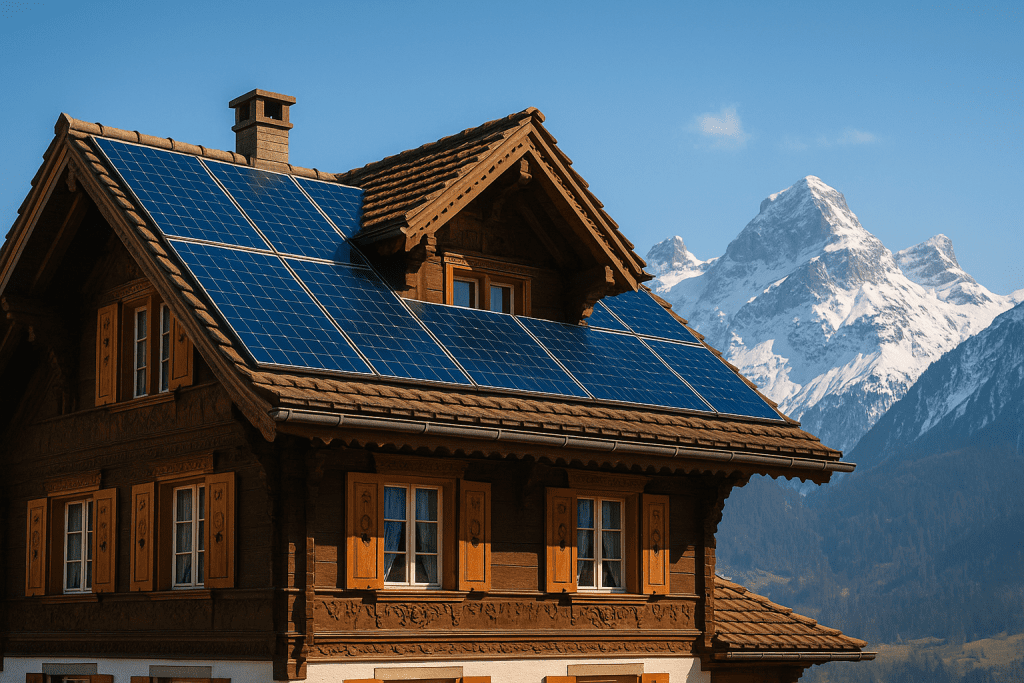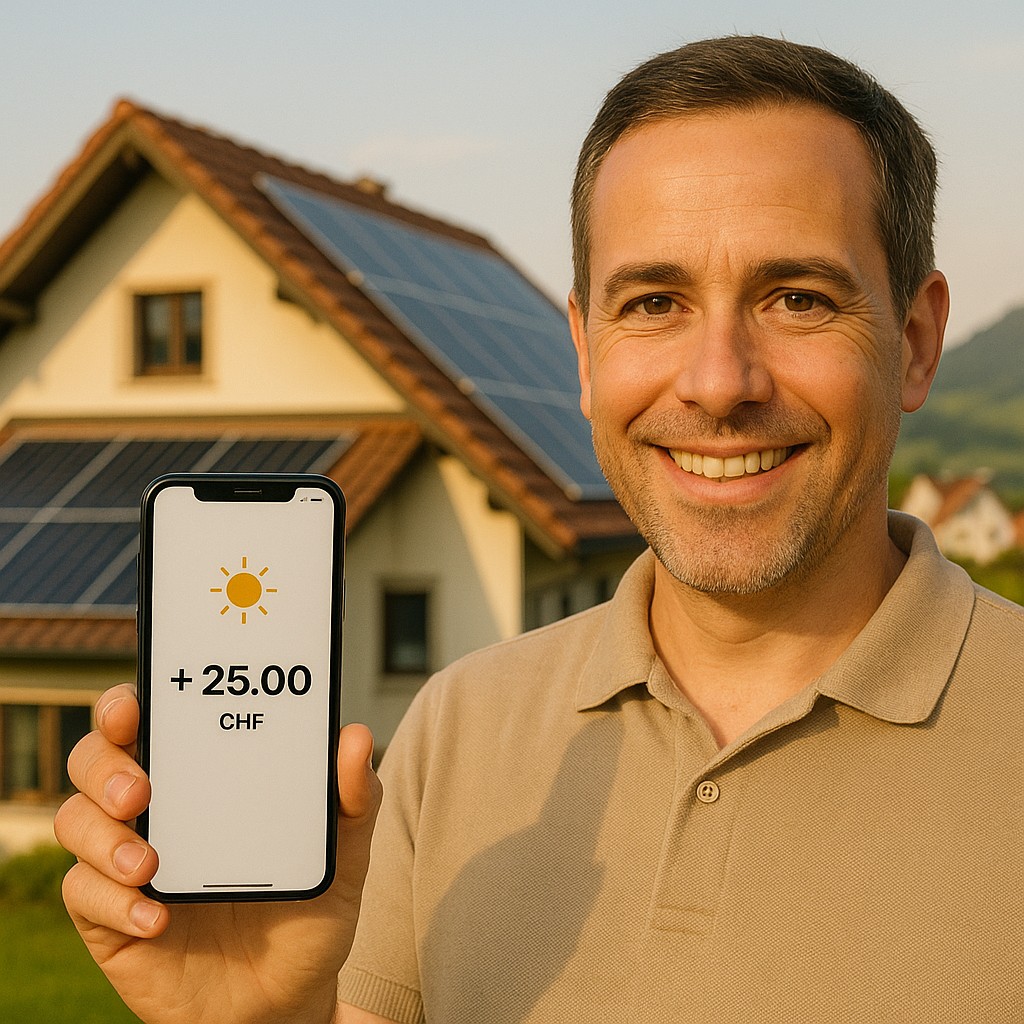Harnessing Sunshine in Schwyz: Your Solar Playbook

Unlock the untapped energy potential of your rooftop. This guide provides a comprehensive playbook for navigating solar panel installation in Canton Schwyz, from understanding your property’s potential to capitalizing on financial incentives and ensuring a future-proof investment.
Want to skip the guide and go straight to checking your roof’s earning potential?
Get a Free Solar Proposal for Your RoofSchwyz’s Solar Potential: More Sun Than You Think
Imagine the familiar, breathtaking vista of sun-drenched chalets perched above Lake Lucerne. Now, picture their roofs glinting, not with snow, but with sleek, dark photovoltaic (PV) arrays silently converting Alpine sunlight into clean, valuable electricity. This vision is rapidly becoming a reality across Canton Schwyz.
While known for its dramatic landscapes, Schwyz is also a powerhouse of solar potential. The region boasts significant annual sunshine, with global horizontal irradiation values on the Swiss Plateau, where much of the canton lies, ranging from 1,120 to over 1,400 kilowatt-hours per square meter (kWh/m²). In the higher Alpine regions, this potential is even greater. To put that in perspective, every square meter of an optimally placed solar panel can generate a significant portion of the electricity needed to power a modern, energy-efficient refrigerator for a full year.
This high solar yield, combined with a supportive framework of federal and cantonal incentives, makes investing in solar energy more attractive than ever. As retail electricity prices remain a significant household expense, generating your own power is a direct path to substantial savings and energy independence. In fact, since May 2022, Canton Schwyz has mandated some form of on-site electricity generation for all new buildings, underscoring the commitment to a solar future.
PV Installation Practices: Roof, Ground & Permits
Fortunately, Switzerland has streamlined the process for solar installations. However, understanding the rules for different system types and locations is crucial for a smooth project.
Installation Types
- Rooftop Installations: The most common choice for residential and commercial buildings, making use of existing structures. Installations that are well-integrated and not on protected heritage sites are often subject to a simplified notification process.
- Façade Installations: Mounting panels vertically on building walls is an increasingly popular option, especially for capturing low-angle winter sun. These can be subject to aesthetic considerations but are often encouraged through specific financial bonuses. The federal government’s sonnenfassade.ch tool can even estimate the solar potential of your building’s facade.
- Ground-Mounted Systems: Less common for private homes but an option for properties with sufficient land, particularly in agricultural or commercial zones. These almost always require a full building permit. Ambitious large-scale projects, like the planned “Alpin Solar Ybrig,” are exploring this option in the canton.
In Canton Schwyz, the need for a formal building permit depends on the project’s specifics.
- Notification Process (Meldeverfahren): Most rooftop solar installations on existing buildings that are not located in core zones, historic preservation zones, or on culturally significant buildings fall under a simple notification duty. You must register your solar project with the local building authority through the eBau online portal, but you generally do not need to wait for formal approval to begin.
- Building Permit (Baubewilligungsverfahren): A full permit is required for installations on buildings listed as worthy of protection or located in designated protected zones, such as those listed in the Cantonal Protection Inventory or the Federal Inventory of Swiss Heritage Sites (ISOS). It is also typically required for ground-mounted systems and installations that deviate significantly from standard building norms.
Expert Tip: Always contact your local municipal building authority (Bauamt) early in the planning process. They can provide definitive guidance on whether your project requires a simple notification or a full permit, saving you time and preventing potential compliance issues.
Solar System Sizing & Payoff in Schwyz: Maximize Your Kilowatts
In Canton Schwyz, as across much of Switzerland, solar systems have traditionally been designed to match current household electricity use—primarily to reduce high utility costs through self-consumption. While this has economic merit, it often leaves large portions of viable roof space unused—wasting potential energy and long-term savings.
Why consider full-roof coverage for solar in Schwyz?
Here are three compelling reasons to make the most of your rooftop:
- Think long-term about your energy needs
Today’s PV systems are designed to operate efficiently for 30–40 years. Instead of sizing based solely on current usage, it’s worth planning ahead. In Schwyz, more and more homes are transitioning to EVs, electric heating, and smart tech—causing electricity demand to steadily rise. A small system based on yesterday’s needs may fall short within just a few years.
- Future upgrades aren’t always simple—or cheap
Adding more panels later isn’t just plug-and-play. It may require revisiting permits, redoing scaffolding, possibly upgrading your inverter, and hiring installers all over again. Some municipalities in Schwyz may also require new authorizations. A larger, one-time installation often saves money and effort in the long run.
- Earn money from your surplus solar power
Schwyz homeowners can benefit from Switzerland’s legal options like ZEVs (joint self-consumption), virtual ZEVs, and Local Electricity Communities (LEGs). These allow you to share or sell excess solar power directly to nearby consumers—not just the grid—turning your rooftop into a source of local revenue.

Not ready to invest fully? Alternatives exist.
If the upfront cost of a full system is too high, you still have alternatives. In Schwyz, some solar providers offer Power Purchase Agreements (PPAs) or rooftop leasing models. They handle installation and operation, while you benefit from rental income or reduced electricity rates—with no initial outlay.
How Your Consumption Patterns Shape Your Solar Setup
To get the best return on your solar investment in Schwyz, it’s essential to understand how your building consumes electricity. Whether you’re planning for a private residence or a multi-unit property, reviewing your past 12 months of electricity bills—or requesting detailed load profiles from your energy supplier—will help guide your system design.
You can boost solar efficiency by shifting high-consumption tasks—like washing clothes, charging electric vehicles, or heating water—into daylight hours, when your PV system is most productive. That said, even with smart usage habits, self-consumption without a battery usually tops out around 30%. If you’re aiming for 80–90% energy independence, a storage solution is key to making use of surplus energy in the evening or at night.
Cost Breakdown & Real-World Payback in Canton Schwyz
An investment in a solar PV system is a significant financial decision. Understanding the components of the cost and the expected payback period is essential.
Typical Cost Components
For a standard 10 kWp system in Switzerland, the costs can be broken down as follows:
| Component | Typical Cost Range (CHF) |
|---|---|
| PV Modules | 4,000 – 10,000 |
| Inverter | 2,500 – 4,000 |
| Mounting System & Installation | 4,000 – 7,000 |
| Planning, Scaffolding & Electrical | 8,500 – 11,500 |
| Total (Excluding Battery) | 19,000 – 32,500 |
| Optional: Battery Storage (10 kWh) | 8,000 – 14,000 |
Source: Adapted from market estimates for 2024/2025. Costs are indicative and can vary.
Find out how you can profit from your rooftop solar without upfront investment costs.
Get a Free Solar Proposal for Your RoofPayback Period at a Glance
The payback period depends heavily on the initial cost, the amount of subsidies received, the price of electricity, and your self-consumption rate. With current incentives, a well-planned system can offer attractive returns.
| Self-Consumption Rate | Payback Period with Subsidies |
|---|---|
| 30% (No Battery) | 10 – 14 years |
| 70% (With Battery) | 8 – 11 years |
| 80%+ (Battery + EV/Heat Pump) | 7 – 10 years |
Note: These are estimates. The rising cost of grid electricity shortens the payback period, while the variable feed-in tariffs for surplus power make maximizing self-consumption even more critical.
The Local Solar Market: Installers & Flagship Projects
Choosing the right partner to design and install your PV system is as important as the components themselves.
Vetting Your Installer
A trustworthy installer is the cornerstone of a reliable, long-lasting solar energy system. Look for these key qualifications:
- Local Presence and References: Choose a company with a proven track record in Canton Schwyz. Ask for references and, if possible, visit a completed installation in your area.
- Comprehensive On-Site Audit: A professional installer will conduct a thorough on-site analysis, including shading measurements and a structural roof check, rather than relying solely on satellite images.
- Transparent, Detailed Quotes: Obtain at least two to three comparable quotes. Ensure they detail the specific brands and models of panels and inverters, all associated costs, and clear warranty information.
Prominent energy providers and installers active in the region include EWS, and a variety of specialized local and national solar firms.
Flagship Projects
Canton Schwyz is actively promoting solar energy. Beyond individual rooftops, ambitious projects are underway. Axpo and the local utility EWS are planning “Alpin Solar Ybrig,” a 9 MWp ground-mounted solar plant at 1,600 meters above sea level, designed to provide crucial winter electricity for over 2,600 households. Even more innovative concepts have been tested in the canton, such as placing solar panels on railway infrastructure.
Subsidies & Incentives: Turning Sunshine Into Swiss Francs
Switzerland offers a robust, multi-layered incentive structure to reduce the upfront cost of going solar. These programs are managed at the federal and cantonal levels.
Federal Subsidies (Pronovo)
The federal agency Pronovo manages the primary financial incentives for PV systems.
- One-Time Remuneration (EIV): This is the main subsidy for most homeowners. It consists of a base payment plus a performance-based payment per kWp. For a standard 10 kWp system, this amounts to 3600 francs in 2025. You apply for the subsidy after the system is commissioned. Calculate your subsidy in the Pronovo calculator.
- High One-Time Remuneration for installations without self-consumption (HEIV): For systems that feed 100% of their power to the grid, this subsidy can cover up to 60% of the investment costs of a reference system.
- Auctions for Large Systems: For systems over 150 kWp feeding 100% of their power to the grid, subsidies are awarded through a competitive auction process for HEIV or for floating market premium (GMP) , where the subsidy is based on the electricity fed in in centimes per kWh over a fixed remuneration period of 20 years.
Cantonal and Other Bonuses
- Gebäudeprogramm: In Canton Schwyz, this program primarily provides financial support for thermal solar systems (for hot water) and other energy-efficient building renovations.
- Facade & High-Inclination Bonus: To encourage winter energy production, Pronovo offers significant bonuses for systems with a tilt of 75 degrees or more (i.e., vertical facades).
- Tax Deductions: The cost of the solar installation can typically be deducted from your taxable income as a value-preserving property investment, offering additional savings.
Tariffs, Feed-in & Self-Consumption Rules
The financial attractiveness of a PV system is defined by the relationship between what you pay for electricity and what you get paid for the surplus you sell.
- Retail Electricity Tariff: This is the price you pay for every kWh you draw from the grid. In recent years, this price has been volatile but remains significantly higher than feed-in tariffs, making every kWh you produce and consume yourself highly valuable.
- Feed-in Tariff (Rückliefervergütung): This is the rate your utility pays for the electricity you export to the grid. These rates vary by utility but are generally based on market prices and are substantially lower than the retail price.
This price difference creates a powerful incentive to maximize self-consumption. One self-consumed kWh can be worth three or four times more than one exported kWh.
New Rules to Boost Self-Consumption
The revised Swiss Energy Act introduces new models to boost self-consumption:
- Joint Self-Consumption Model: The “Zusammenschluss zum Eigenverbrauch” (ZEV), or joint self-consumption model, is a robust legal mechanism that enables several parties—whether within a single building or across multiple properties—to collectively generate and use solar energy as one unified group.
- Virtual Self-Consumption Communities (vZEV): This model allows residents in different apartments or even adjacent buildings to form a “virtual” community to share solar power without complex physical rewiring, using the utility’s smart meters for billing. From 1.1.2025
- Local Electricity Communities (LEG): These will allow for the sale of solar power within a neighborhood or municipality using the public grid at a reduced network tariff, further incentivizing local energy sharing. From 1.1.2026, stay tuned
Solar Contracting Options in Schwyz: Buy, Lease, or Earn from Your Roof
In Canton Schwyz, property owners can benefit from solar power through various models—ranging from full ownership to third-party arrangements. Each approach comes with different levels of investment, financial risk, and potential returns.
- Full Ownership
This is the classic model, particularly popular among single-family homeowners. You purchase and own the PV system outright, giving you access to all federal incentives, feed-in compensation, and long-term electricity savings throughout the system’s 30+ year life span.
- Best for: Owners with sufficient capital or financing who seek maximum control and the highest financial return over time.
- Solar Leasing
With leasing, a solar company installs and owns the system on your roof, and you pay a monthly fee to use the generated electricity. Your upfront costs are minimal, but the provider keeps any subsidies and earnings from excess power fed into the grid. Some contracts offer an option to buy the system later.
- Best for: Residents looking for a low-barrier entry into solar energy without major investment.
- Power Purchase Agreement (PPA)
In a PPA setup, the PV system is funded and owned by an external provider. You agree to purchase the electricity it produces—typically at a lower rate than your utility tariff. In Schwyz, this model is gaining ground for multi-family properties, co-owned buildings, and small businesses where individual ownership is more complex.
- Best for: Property groups or neutral investors who want predictable costs and clean energy without owning the system.
- Roof Rent (Dachmiete)
Here, you lease your unused rooftop space to a solar developer, who installs and operates the system. You don’t use the electricity yourself but receive rental income from the operator, who either sells the power to tenants or feeds it into the grid.
- Best for: Owners of large or idle roofs in Schwyz seeking passive income without financial commitment.
- Hybrid Solutions: Roof Rental with Revenue Share
For expansive roof areas—on barns, schools, or industrial buildings—some developers offer combined models. You lease the roof and optionally co-invest in the system, receiving both rent and a portion of the electricity revenue.
- Best for: Owners who want to blend passive earnings with partial investment for higher returns and local impact.
For most residential scenarios in Schwyz, direct ownership, financed by a combination of savings, subsidies, and potentially a green loan, offers the best long-term value.
Your 7-Step Roadmap to a Schwyz PV System
Embarking on your solar journey can be broken down into a clear, manageable process:
- Initial Assessment & Consultation: Contact a certified installer for an initial consultation. Define your energy needs (including future plans like an EV or heat pump).
- On-Site Audit & System Design: The installer will visit your property to assess your roof, take shading measurements, and design a system tailored to your specific conditions.
- Receive and Compare Quotes: Obtain detailed, itemized quotes from at least two to three reputable installers.
- Contract and Financing: Sign a contract with your chosen installer that specifies a clear project timeline and payment milestones. Arrange financing if needed.
- Permits and Notification: The installer will typically handle the notification or permit application with the local Schwyz authorities via the eBau portal.
- Installation and Commissioning: The technical team will mount the panels, install the inverter, and connect the system to the grid. The utility provider will give the final approval for commissioning.
- Subsidy Application and Monitoring: Once the system is officially running, submit your application for the Pronovo one-time payment (EIV). Your installer typically does this for you. Set up your system’s monitoring to track your production and consumption.
Conclusion – How to make the most out of PV in Schwyz
The sun that illuminates the peaks and valleys of Canton Schwyz is one of its most valuable and underutilized natural resources. By harnessing this power, you are not just making a sound financial investment with a clear payback; you are contributing to Switzerland’s energy security, increasing your property’s value, and taking a tangible step towards a sustainable future.
The journey begins with a single step. By leveraging the comprehensive federal subsidies, understanding the local regulations, and partnering with a qualified professional, you can transform your roof from a passive shelter into an active source of clean energy and financial savings. The time to invest in solar is now—let the Alpine sun start working for you.
Ready to start? Whether you want to own the system or simply rent out your roof for passive income, Solergy can help.
Get a Free Solar Proposal for Your RoofNot in Schwyz?
Discover solar opportunities and incentives in your canton.





